DeepSeek R1 vs OpenAI O1: An In-Depth Comparison

OpenAI and DeepSeek are emerging as dominant players in the development of advanced language models, each bringing distinct strengths to the table. Their latest models, OpenAI's O1 and DeepSeek's R1, represent significant strides in AI reasoning and problem-solving. While OpenAI's O1 is engineered for complex scientific and professional applications, DeepSeek's R1 offers a cost-effective, open-source alternative with strong capabilities in math and coding.
This article explores a direct comparison between OpenAI’s O1 and DeepSeek’s R1, analyzing their architecture, performance benchmarks, and overall impact on the AI landscape.
OpenAI O1: Advanced AI for Complex Reasoning
Released on December 5, 2024, OpenAI’s O1 model was designed with an emphasis on deep reasoning and problem-solving capabilities. It incorporates innovative mechanisms to enhance accuracy and logical coherence, making it a powerful tool for scientific and professional applications.
PromptLayer is specifically designed for capturing and analyzing LLM interactions. Providing insights into prompt effectiveness, model performance, and overall system behavior.
With PromptLayer, your team can access:
- Prompt Versioning and Tracking
- Performance Monitoring
- Cost Analysis
- Error Detection and Debugging
- Frontier LLMs
Manage and monitor prompts with your whole team. Get started here.
Technical Specifications
- Context Window: O1 supports up to 200,000 tokens, allowing it to process extensive inputs efficiently.
- Reasoning Tokens: The model employs an internal chain-of-thought process, breaking down complex tasks before generating responses, improving its ability to analyze and refine its output.
Capabilities and Performance
O1 demonstrates expertise in several key domains:
- Scientific Reasoning: Excels at annotating data and generating mathematical proofs.
- Mathematics: Ranked among the top 500 U.S. students in the AIME (American Invitational Mathematics Examination).
- Coding: Achieved an 89th percentile ranking on Codeforces, showcasing strong problem-solving and debugging skills.
- Data Analysis: Handles SQL query generation and large dataset analysis for financial applications.
Strengths and Weaknesses
| Strengths | Weaknesses |
|---|---|
| Exceptional academic and coding benchmarks | Higher computational costs |
| Advanced reasoning capabilities | Slower response times |
| Vision API integration for image analysis | Limited streaming output support |
User Experiences
O1 has been widely praised for its ability to tackle deep reasoning problems. However, users note that its slower response times and strict adherence to OpenAI’s policies can sometimes limit flexibility in responses. Prompt engineering is often required to get the most optimal results from O1.
DeepSeek R1: Open-Source AI with Strong Mathematical Reasoning
DeepSeek introduced R1 on January 21, 2025, positioning it as an accessible, cost-effective alternative to proprietary AI models. It is built on a unique reinforcement learning-based methodology, emphasizing affordability and transparency in AI development.
Technical Specifications
- Model Architecture: R1 employs a Mixture-of-Experts (MoE) design with 671 billion parameters, but activates only 37 billion per token generation, optimizing efficiency.
- Context Window: Supports 128,000 tokens, facilitating complex reasoning tasks.
Capabilities and Performance
DeepSeek R1 excels in:
- Mathematical Reasoning: Scored 91.6% on the MATH benchmark, making it a strong contender in problem-solving.
- Coding: Demonstrates a high success rate in generating and debugging code, outperforming many closed-source models.
- Logical Problem-Solving: Uses chain-of-thought reasoning to verify and refine responses.
Strengths and Weaknesses
| Strengths | Weaknesses |
| Open-source, enabling community-driven improvements | Occasionally verbose in outputs |
| Cost-efficient (90-95% cheaper than O1) | Slightly slower processing speeds |
| Transparent reasoning process | Less polished responses compared to chat-optimized models |
User Experiences
Users appreciate R1’s open-source nature and the visibility into its reasoning process. The model’s self-verification and “overthinker” tool allow it to extend its reasoning process, but some find it overly verbose or slightly slower in generating responses.
O1 vs R1: Direct Feature Comparison
| Feature | OpenAI O1 | DeepSeek R1 |
| Context Window | 200,000 tokens | 128,000 tokens |
| Model Size | Not publicly disclosed | 671B total, 37B active |
| Architecture | Reasoning tokens, deep learning | Mixture-of-Experts (MoE) |
| Training Method | Reinforcement learning & structured datasets | Pure reinforcement learning (GRPO) |
| Cost per 1M Input Tokens | $15.00 | $0.55 |
| Open Source | No | Yes |
| Key Strengths | Scientific reasoning, complex problem-solving | Mathematical reasoning, cost efficiency |
| Key Weaknesses | Higher costs, slower responses | Verbose outputs, slower speeds |
Company Backgrounds
OpenAI
Founded in 2015, OpenAI is a leading AI research lab focused on the development of safe and powerful AI systems. Operating under a capped-profit model, OpenAI collaborates with organizations like Microsoft and academia to push the boundaries of artificial intelligence.
DeepSeek
DeepSeek, established in 2023, is a Chinese AI company emphasizing open-source innovation. Backed by High-Flyer Capital, DeepSeek has made a name for itself by offering cost-effective AI models that challenge proprietary industry leaders like OpenAI.
Last Thoughts
OpenAI’s O1 and DeepSeek’s R1 embody two distinct AI philosophies. O1’s superior reasoning abilities make it ideal for complex academic and professional tasks, while R1’s open-source framework and cost-efficiency appeal to developers and researchers looking for a scalable, transparent AI model.
Ultimately, the choice between O1 and R1 depends on use case priorities—whether one values cutting-edge, high-stakes AI performance (O1) or affordability and community-driven development (R1). As competition between OpenAI and DeepSeek continues, both models will likely see further advancements, shaping the future of AI reasoning.
About PromptLayer
PromptLayer is a prompt management system that helps you iterate on prompts faster — further speeding up the development cycle! Use their prompt CMS to update a prompt, run evaluations, and deploy it to production in minutes. Check them out here. 🍰



